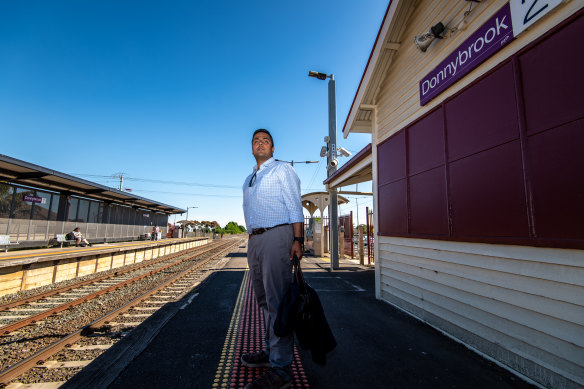By Adam Carey
A developer’s billboard promoting a master-planned community with all the amenities lured Sameer Sharma to buy a house in the new Cloverton estate two years ago.
“The way they advertised everything, that it is going to be close by the train station, to schools; also the affordability,” Sharma said.

Cloverton resident Sameer Sharma relies on the infrequent Seymour line to commute to work in Melbourne’s CBD.Credit: Justin McManus
The developer’s promises weren’t plucked out of thin air. They were taken from a government plan gazetted in state parliament in 2012. The precinct structure plan approved for this part of Melbourne’s outer north includes a potential future train station, a new freeway interchange and seven schools.
But 12 years on from the plan’s adoption, three schools have opened for the burgeoning community, while most of the infrastructure listed in the plan remains unbuilt and, in some cases, still unconfirmed. The “potential future Lockerbie train station” remains a speculative dot on a map.
Sharma commutes to and from Melbourne’s CBD each day on the Seymour line, catching crowded and infrequent trains from Donnybrook station. There are four trains to the city in the two-hour peak between 7am and 9am, then an hourly train, at best, outside the peak. The last train home leaves the city at 9.43pm. It’s a sleepy country service for a booming suburban population.
“It’s not the way you want to live. You get up, spend 20 minutes battling through traffic to reach the station; you stand up on the train for 50 minutes, and then you get into the city,” Sharma said.
Sharma’s community of Cloverton is part of the Lockerbie precinct structure plan (PSP). Urban growth in Melbourne’s outer-suburban greenfields is guided by more than 100 PSPs, which lay out the long-term vision for how each precinct will develop.
Without an approved PSP, new housing in Melbourne’s greenfields cannot proceed.
The Allan government released a 10-year plan for Melbourne’s 27 remaining undeveloped PSPs last week, laying out a timeline for building 180,000 homes in fringe suburbs such as Melton, Sunbury, Mambourin, Wallan, Clyde and Cardinia.
But approval of new greenfields land has virtually stalled in Victoria. The government last approved a PSP almost three years ago, in March 2022.
The new 10-year plan also pushes back plans for new greenfield estates in Wallan by several years.
Planning experts say the government is deliberately stymying growth in greenfield areas, in part because it knows it cannot afford to build infrastructure such as train stations and schools at a rate that keeps pace with population growth.
Property sector analysts have also warned the government that the planning slowdown threatens to push up house prices in the last affordable parts of Melbourne.
In its submission to Plan for Victoria, property services group Oliver Hume said the trickle of land releases risked pushing up property prices to levels akin to Sydney’s sky-high prices.
The lack of available greenfields land in Sydney has helped push median house prices in the city’s growth areas 77 per cent higher than in Melbourne.
“Outer Sydney’s median house price sits at around $1.1 million, which is a substantial 77 per cent premium on the Melbourne growth area median house price of $672,000,” Oliver Hume said.
“Melbourne faces a substantial risk of replicating Sydney’s housing market challenges if it continues to constrain land supply.”
Andrew Butt, professor in sustainability and urban planning at RMIT University, said the slowdown in the release of new land for housing could be interpreted in two ways: as an attempt by the state government to get its target to build 70 per cent of housing in established areas on track, and a recognition that it was failing to build infrastructure at a pace the growth areas need.
“There is a deliberate strategy there,” one planning insider said, requesting anonymity because they remain involved in greenfield planning with the Victorian Planning Authority.
“I think that the investment in those communities is perceived to be too costly.”
The 10-year plan for Melbourne’s greenfields will also revisit existing precincts to see if housing can be built at greater density. Butt said this question would determine how quickly the remaining undeveloped greenfield land on Melbourne’s fringe is built.
“If you want to get it delivered today, you build to the standard densities without enough infrastructure. And if you want to get it built at a better density, you do it in the future when you can build the proper infrastructure.”
Oliver Hume chief executive Julian Coppini criticised the government’s inaction on greenfield planning, arguing it was denying home buyers choice.
“We need to be building the affordable homes people want, not unaffordable apartments in the inner city because the government doesn’t want to build the infrastructure required,” he said.
Start the day with a summary of the day’s most important and interesting stories, analysis and insights. Sign up for our Morning Edition newsletter.
correction
An earlier version of this story reported that there is one school in the Cloverton estate.